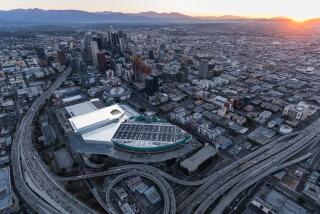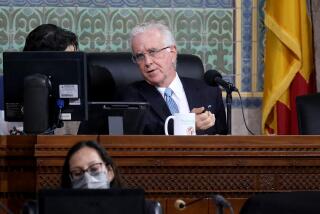Commentary : Council Must Act Now on Growth : Growth: Clearly a response by the City Council is a preferred way to deal with the problems. But that has not happened to date.
Last November, the voters rejected two growth-control measures in the city of San Diego. Now, another growth initiative is being sponsored by a group of concerned citizens called Prevent Los Angelization Now! who believe that the traditional legislative decision-making process is still unresponsive. Its sponsors hope that the City Council will adopt its provisions, and if not, they will attempt to qualify the initiative for the June or November, 1990 ballot.
Another group has announced its intent to sponsor an initiative that would compete with PLAN. The likely result is voter confusion.
Clearly a response by the City Council is a preferred way to deal with land-use problems. But that has not happened to date. If the council waits much longer, the failure to act will be a stimulus to initiative proponents. San Diego could end up in a situation similar to a year ago, when the voters faced a confusing array of growth initiatives.
The City Council can prevent that by taking timely action on proposals like PLAN’s.
The essence of PLAN’s complaint is that short-term local revenue needs, which are more easily met by pro-development policies, influence our elected officials to support growth and development without making it pay the true costs it imposes on society.
Rapid development is a scissors that is cutting up San Diego’s quality of life. One blade of the scissors represents a decline in basic services in the established communities, particularly in the older urbanized ones, because the city’s overburdened budget can’t meet their needs. The other blade is higher taxes, rates and fees to subsidize the failure to make development pay its fair share--including, for example, a half-cent sales tax to pay for inadequately funded road and public transportation, another half-cent sales tax to pay for jails and courts, increases in water and sewer fees and additional fees for disposal at landfills.
In light of this situation, we should ask: Why did these growth-control measures fail last November? And, how is PLAN different from the failed initiatives?
Clearly, these growth-control measures were not rejected because San Diego has solved its growth-related problems. San Diego continues to experience growth unparalleled in its history. Last year the county added close to 90,000 people with no sign of abatement. Providing adequate public services to accommodate this growth--without an accompanying decline in the quality of life--will be the major challenge for the City Council and county Board of Supervisors in the 1990s.
Two fundamental reasons contributed to the failure of the growth-control initiatives last November. The first was the complexity of the initiatives. Although there are exceptions, the public generally will not vote for initiatives that are difficult to understand. All of the failed growth initiatives--the ones sponsored by Citizens for Limited Growth and the ones sponsored by the city and county governments--were long and complex. And because they covered the same general subject, the public found them difficult to distinguish.
The second contributing factor was the philosophy embodied in the initiatives. Most people would agree that there is nothing inherently wrong with growth. The challenge is successfully planning for it and then effectively managing it. It is poor planning and management to worry and fret about providing sufficient schools, parks, libraries and other necessary public services after the buildings have been constructed and occupied. But the initiatives put before the voters last fall were not responsive to the real problems facing San Diego. They focused on limiting building permits, not planning and management.
Is PLAN different from the failed growth-control initiatives? I would answer with a qualified yes.
Most importantly, it differs from earlier efforts in its philosophy. The theory of PLAN is to make growth pay for the full cost of additional public facilities either before or concurrent with proposed development in order to prevent ensuing taxpayer subsidization of these facilities through higher taxes, rates or fees. The emphasis is on planning and managing the cost of new facilities by having development pay its way, not on artificially limiting growth through caps. In this sense, PLAN addresses the real problem facing the city.
On the downside, PLAN is technically complicated. It is not, however, as complicated as the growth initiatives that failed in last November’s election. Beyond making development pay for its fair share of public facilities in a timely fashion, it incorporates two sound planning principles.
First, new development is not permitted to increase traffic congestion, without implementing offsetting mitigation measures. Second, new development is not permitted to create water shortages, a proposition that is likely to be readily accepted by the voting public. Yet, determining when increased traffic congestion would be properly attributable to proposed development or when a water shortage would be created by it will involve complex administrative determinations.
Citizen-sponsored initiatives ultimately limit the discretion of our elected officials, bypassing public debate and the healthy compromise that results from it.
The City Council should assure this public debate by giving far more attention to PLAN’s initiative than it has thus far, because this proposal cuts to the core of the growth problem by linking new development to meeting reasonable standards for traffic, water and public facilities.
The recent election results suggest that the public is prepared to hold the City Council accountable for its land-use decisions.
More to Read
Sign up for Essential California
The most important California stories and recommendations in your inbox every morning.
You may occasionally receive promotional content from the Los Angeles Times.










